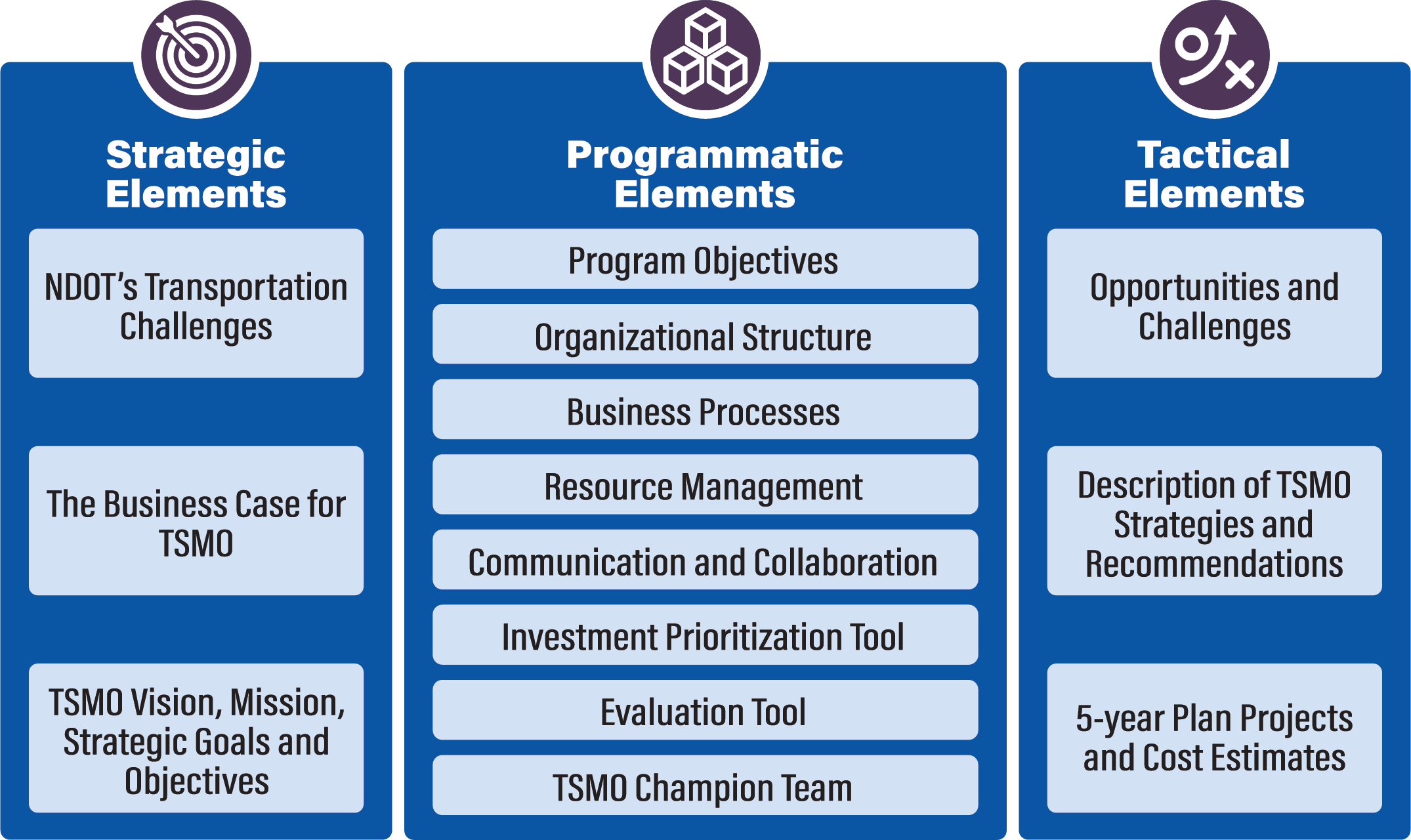TSMO Peer Exchange Video
 What is TSMO?
What is TSMO?
Transportation Systems Management and Operations (TSMO) is technically defined in the Moving Ahead for Progress in the 21st Century Act (MAP-21) as “integrated strategies to optimize the performance of existing infrastructure through the implementation of multi-modal and intermodal, cross-jurisdictional systems, services, and projects designed to preserve capacity and improve security, safety, and reliability of the transportation system.” This definition highlights the focus on enhancing the efficiency and functionality of transportation systems by leveraging coordination and integration across modes, regions, and agencies.
In simpler terms, TSMO is a strategic approach to managing and operating transportation systems. It focuses on optimizing the performance of existing infrastructure through coordinated operations, technology, and data, rather than relying solely on building new infrastructure
 The NDOT Statewide TSMO Program
The NDOT Statewide TSMO Program
NDOT Statewide TSMO Program Plan – Executive Summary
NDOT TSMO Program Plan is a plan for placing Transportation Systems Management and Operations (TSMO) into practice throughout the Nevada Department of Transportation (NDOT). The TSMO Program introduces a set of strategies that support the integration of TSMO into the planning process.
The NDOT TSMO Program Plan builds on a performance-based planning approach to the management and operations of the transportation system by highlighting the successful accomplishment of currently implemented TSMO initiatives in the state of Nevada. This mobility-focused approach identifies end-users’ specific needs, institutionalizes TSMO activities and mobility strategies, and introduces cost-effective solutions to maximize the efficiency of the existing transportation system by addressing the identified end-users’ needs.
 Why TSMO?
Why TSMO?
With projected population and traffic growth in Nevada, increases in system demand, technological advancements, and limited funding, NDOT recognizes the significance of embracing TSMO to facilitate more comprehensive management and operations of the transportation system. This performance-driven program focuses on the surface transportation system and the policies and business processes that are applied to manage and operate this system in the most effective way possible. The TSMO Program introduces an innovative approach by integrating multiple disciplines, breaking down unproductive barriers, and formalizing processes to maximize collaboration with internal and external stakeholders.
Strategies offered by TSMO are used to proactively address transportation challenges (such as recurring and/or non-recurring congestion, safety, mobility, and reliability). This performance-driven program focuses on the surface transportation system and the policies, business processes, technologies, infrastructure, and systems applied to manage and operate this system more efficiently. A summary of the business case for TSMO and a discussion of some TSMO strategies as they relate to the challenges Nevada is provided below:
TSMO Business Case for Divisions
 What will TSMO do for NDOT?
What will TSMO do for NDOT?

TSMO solutions play a critical role in addressing transportation challenges, such as congestion, safety, and reliability. To implement these solutions effectively, collaboration between internal stakeholders (e.g., NDOT divisions) and external partners (e.g., Regional Transportation Commissions and local agencies) is essential. Through partnerships, TSMO can become a core function in transportation management. Tools like the TSMO Evaluation Tool can help identify opportunities to integrate TSMO strategies and address operational challenges systematically, ensuring more efficient and reliable transportation systems.
The NDOT TSMO Program Plan presents a five-year action plan to implement the TSMO Program as part of a cross-jurisdictional approach to achieve Nevada’s transportation vision and objectives. The Program Plan includes three main components:
- Strategic Elements
- Programmatic Elements
- Tactical Elements
These components and elements are developed in alignment with the Federal Highway Administration (FHWA) TSMO Primer as well as the One Nevada Transportation Plan to ensure transportation efforts are aligned at both national and agency levels. This plan includes recommendations on the update cycle of the specific elements to ensure all TSMO efforts are up to date.

